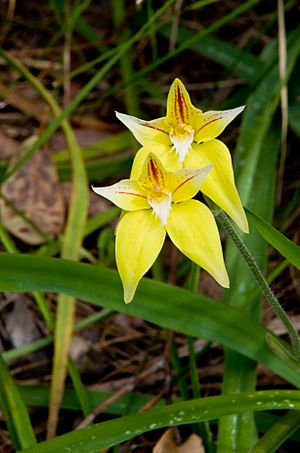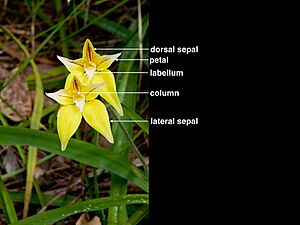Caladenia flava subsp. flava facts for kids
Quick facts for kids Caladenia flava |
|
|---|---|
 |
|
| Scientific classification |
|
| Kingdom: | Plantae |
| Clade: | Tracheophytes |
| Clade: | Angiosperms |
| Clade: | Monocots |
| Order: | Asparagales |
| Family: | Orchidaceae |
| Subfamily: | Orchidoideae |
| Tribe: | Diurideae |
| Genus: | Caladenia |
| Species: | |
| Subspecies: |
C. f. subsp. flava
|
| Trinomial name | |
| Caladenia flava subsp. flava |
|
The cowslip orchid (scientific name: Caladenia flava subsp. flava) is a beautiful wild orchid. It grows only in the south-west part of Western Australia. This orchid is quite common. It has one fuzzy leaf and usually one to three bright golden-yellow flowers. These flowers often have pretty red marks on them.
Contents
What Does the Cowslip Orchid Look Like?
The cowslip orchid is a ground-dwelling plant. It is a perennial herb, meaning it lives for many years and its leaves die back each year. It grows from an underground tuber, which is like a small potato. These orchids often grow in large groups, sometimes with thousands of plants together!
Each plant has one broad, hairy leaf. This leaf is usually about 6 to 12 centimetres (2.4 to 4.7 inches) long and about 1 centimetre (0.4 inches) wide. The leaf is often reddish or purplish on its underside.
The orchid usually has one to three flowers, but sometimes four. These flowers are about 2 to 5 centimetres (0.8 to 2 inches) long and 2 to 4 centimetres (0.8 to 1.6 inches) wide. They grow on a stem that is 10 to 25 centimetres (3.9 to 9.8 inches) tall.
The flower's parts, called sepals and petals, are short and wide. They come to a point and spread out stiffly. They are usually bright yellow, but can sometimes be pinkish or white. They often have magenta (a reddish-purple colour) markings.
- The top sepal (called the dorsal sepal) stands straight up. It is about 1.5 to 2.5 centimetres (0.6 to 1 inch) long. It often has a reddish line or spots down its middle.
- The side sepals are bigger, about 2 to 4 centimetres (0.8 to 1.6 inches) long.
- The petals are about 1.2 to 2.4 centimetres (0.5 to 0.9 inches) long.
The special lower petal, called the labellum, is about 1 to 1.5 centimetres (0.4 to 0.6 inches) long and wide. It has three parts, or lobes. The side lobes are egg-shaped and sometimes have small, club-shaped teeth. The middle lobe has four to six upright teeth. There are also two rows of small bumps, called calli, in a U-shape along its centre.
The flowering season for the cowslip orchid is from July to early December.
How is this Orchid Different from Others?
There are other types of Caladenia flava orchids.
- Caladenia flava subsp. maculata has lemon-yellow flowers with brown or red blotches. It usually grows north of Geraldton.
- Caladenia flava subsp. sylvestris has pale yellow sepals and petals that are white at their tips. It has bright red or pink spots in a line on its top sepal. This type mostly grows between Albany and Bunbury.
Naming the Cowslip Orchid
The cowslip orchid was first officially described in 1810 by a botanist named Robert Brown. He wrote about it in his book Prodromus Florae Novae Hollandiae et Insulae Van Diemen. He studied a plant sample collected by Archibald Menzies.
Later, in 2001, two other scientists, Stephen Hopper and Andrew Phillip Brown, described three different types (subspecies) of Caladenia flava. They published their findings in a science journal called Nuytsia.
The name flava comes from a Latin word. It means "golden-yellow," which perfectly describes the colour of this orchid's flowers!
Where Does the Cowslip Orchid Grow?
The cowslip orchid grows in many different kinds of soil. You can often find it in areas that get wet in winter. It lives in forests, coastal woodlands, and on granite rock outcrops.
It is found between Geraldton and Israelite Bay in most of the South-West Province of Western Australia. It also grows in the Coolgardie region. Sometimes, you can see these orchids growing near burnt trees, like the marri gum tree.
Is the Cowslip Orchid Endangered?
Good news! The Western Australian Government's Department of Parks and Wildlife has classified Caladenia flava subsp. flava as "not threatened." This means it is not currently at risk of disappearing.


